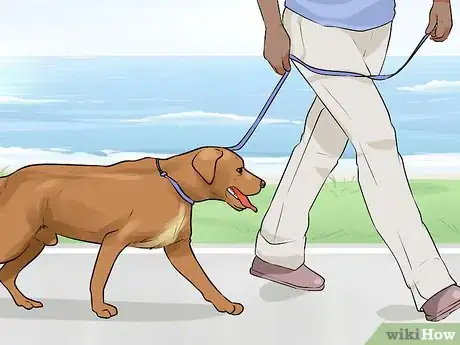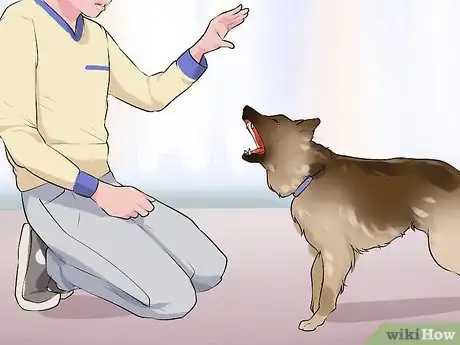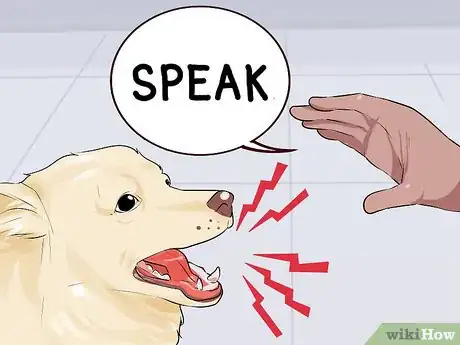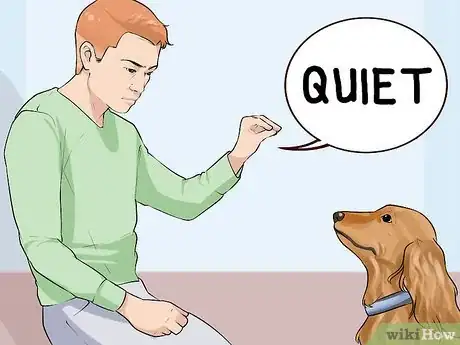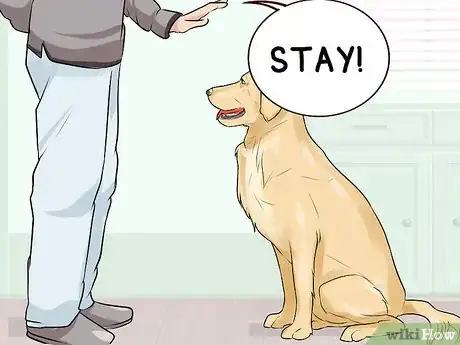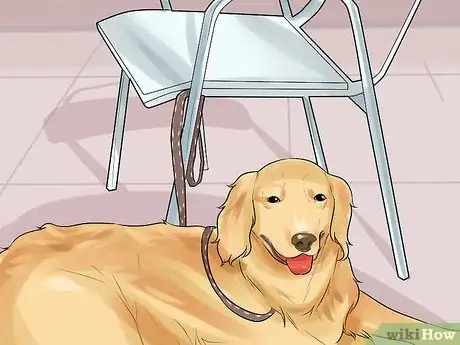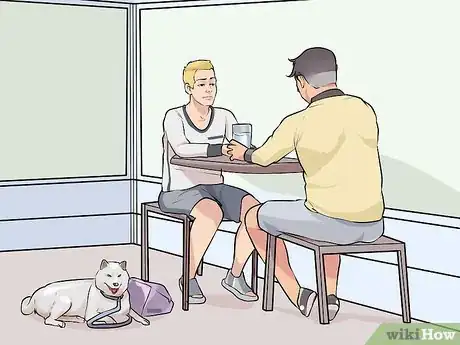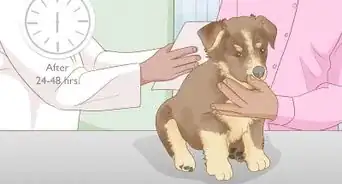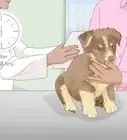This article was co-authored by Ryan Corrigan, LVT, VTS-EVN. Ryan Corrigan is a Licensed Veterinary Technician in California. She received her Bachelor of Science in Veterinary Technology from Purdue University in 2010. She is also a Member of the Academy of Equine Veterinary Nursing Technicians since 2011.
This article has been viewed 24,764 times.
If you've found a restaurant that welcomes dogs, remember that even dog-friendly establishments expect your canine pal to be well behaved. Keeping your dog busy with chew toys, treats, or food puzzles will help keep your dog under control while dining at a restaurant. However, before taking your dog to any restaurant, make sure it understands the “quiet” command, as well as basic commands like sit, stay, and come. Keeping your dog on a short leash and choosing a quiet corner are further steps you can take to ensure that your dog is well behaved at any restaurant.
Steps
Keeping Your Dog Busy
-
1Take your dog for a walk beforehand. A tired dog is a well behaved dog. Before you bring your dog to a restaurant, take it for a long walk, to the dog park, or play a tiring game of fetch with your dog. This way, all of your dog’s energy will be depleted and it will be less likely to act up.[1]
- Take your dog out for at least 30 minutes, if not an hour. However, the amount of exercise or play time your dog needs to become tired will depend on its breed, age, and health.
- Make sure your dog is tired out before you bring it to the restaurant.
-
2Bring treats. The availability of food at a restaurant may cause your dog to become restless or beg for food. However, bringing treats along with you can help curb any temptations. Therefore, make sure to bring enough treats with you to keep your dog distracted.[2]
- Make sure to only give your dog treats when it is behaving. In other words, make sure you do not give it treats while it is begging for food. First ask your dog to sit, and then reward it with a treat.
- If there's enough room, have your dog lie under the table. Feed it treats throughout your meal whenever it's being calm and quiet.
Advertisement -
3Give your dog chew toys. Chew toys, food puzzles, and/or treat-dispensing toys are a great way to distract a restless dog. Therefore, make sure to bring plenty of these along with you to keep your dog busy if it becomes restless or overwhelmed.[3]
- For example, Bully Sticks, Kongs, and Adventure Boxes are great high-value treats that will keep your dog busy for at least 10 to 20 minutes.
- Refusing to lick or chew its favorite chew toy is a sign of nervousness. If your dog continues to show signs of anxiety, then ask the server to box up your food and leave.
- If your dog is protective of its toys, skip out on bringing them so it doesn't feel stressed.
-
4Bring a portable water bowl. Your dog might become restless or anxious if it is thirsty. Bring a portable water bowl along with you to ensure that your dog is hydrated. Ask a server to bring a glass of water and pour the water into your dog’s bowl. Make sure to replenish the bowl as needed, especially on hot days.[4]
- Place your dog’s bowl under the table to prevent it from being knocked over by servers' and guests’ feet.
Teaching Your Dog the “Quiet” Command
-
1Teach your dog to bark on cue. Barking is unacceptable behavior for dogs at restaurants, including dog-friendly restaurants. Before bringing your dog to a restaurant, make sure it knows the “quiet” command. To teach your dog the quiet command you will first need to teach it to bark on cue.[5]
-
2Induce your dog to bark. Make your dog bark by either making a barking sound, or by doing something that sets off the barking, like ringing the doorbell or knocking on the door. While your dog is barking, say a cue word, like “speak” and give your dog a treat.[6]
- To reinforce the speak command, use a distinctive hand signal that will cue the command, for example, like waiving your hand or a pointer finger in the air.
- Say, “speak,” again until your dog begins to bark. Reward it for barking by giving it a treat.
- Repeat this step until your dog understands the “speak” command.
-
3Introduce the quiet command. Once your dog can reliably bark on command, introduce the “quiet” command. In a calm environment with little distractions, firmly tell your dog to “speak.” Your dog should begin barking. When your dog begins to bark say, “quiet,” with a distinctive hand gesture. When your dog stops barking, wait a couple seconds, then give it a treat.[7]
- If your dog keeps barking, wait until it stops barking, reward it with a treat. Remember to wait a couple seconds before giving it a treat so it can associate the correct behavior with the treat.
- Add a second or two of silence every day before you give it a treat. Try to work your way up to 10 seconds of silence before giving it a treat.
-
4Reward silence. Reinforce the idea that silence is a desirable trait by actively seeking out your dog and rewarding it for being silent throughout the day. Try to do this once or twice a day.[8]
- For example, if your dog is silently sitting by your feet, reward it with affection and/or treats for being good. While petting your dog you can say, “That’s a good girl (or boy),” and give it a treat.
Ensuring Your Dog Behaves
-
1Make sure your dog knows basic commands. Teaching your dog the basic commands like sit, stay, and come will help you control your dog's behavior at any restaurant. If your dog does not know these commands, it is recommended that you teach your dog these commands yourself, or place it in a basic obedience class before bringing it to a restaurant.[9]
- Find a basic obedience class at your local pet store, or ask your veterinarian for recommendations.
-
2Keep your dog on a short leash. While you are at the restaurant it is important that you keep your dog on a short leash, for example, a leash that does not exceed four feet. You will be able to control your dog better with a short leash. A short leash will prevent your dog from bothering other guests and from retrieving fallen food scraps from other tables.[10]
- Do not attach the leash to the table. Instead, attach the leash to your chair or to your belt loop.
-
3Choose a quiet location. If you know that your dog is restless, or is easily tempted by food, people, or other dogs, then choose a quiet place to sit in the restaurant. Choose a spot that is off in the corner and away from high traffic areas. This way, your dog will be less tempted by external stimuli, and you will be able to keep your dog's behavior under control.[11]
References
- ↑ http://www.humanesociety.org/animals/dogs/tips/how_to_stop_barking.html
- ↑ http://www.dogtrainingnation.com/dog-training-clients/dog-friendly-restaurant-etiquette/
- ↑ http://www.dogtrainingnation.com/dog-training-clients/dog-friendly-restaurant-etiquette/
- ↑ http://www.dogtrainingnation.com/dog-training-clients/dog-friendly-restaurant-etiquette/
- ↑ http://www.humanesociety.org/animals/dogs/tips/how_to_stop_barking.html
- ↑ http://www.humanesociety.org/animals/dogs/tips/how_to_stop_barking.html
- ↑ http://www.humanesociety.org/animals/dogs/tips/how_to_stop_barking.html
- ↑ http://www.canineminded.com/teach-dog-speak-quiet-command/
- ↑ http://petfriendlytravel.com/news?id=13
About This Article
To get your dog to behave in a restaurant, keep it busy and satisfied by bringing along treats, chew toys, and a portable water bowl. You can also tire your dog out beforehand, so it's less likely to act up, by going on a long walk or taking it to the dog park first. If you think your dog needs additional training, teach it to be quiet on command by first teaching it to "speak." Once your dog can reliably bark on command, get it to speak, then ask it to be quiet and reward it with a treat a few seconds after it stops barking. For more tips from our Veterinary co-author, including how to ensure your dog is comfortable at a restaurant, read on!
